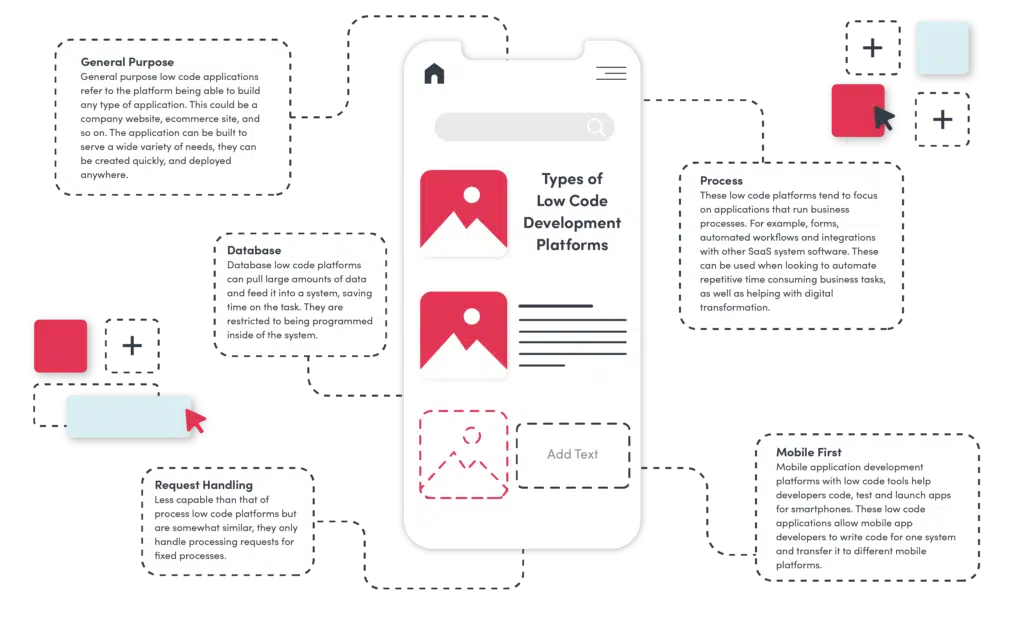Due to several factors the development of low-code applications is more accessible to non-developers. These are sometimes referred to as "citizens developers."
Drag-and-Drop Builders : Low-code platforms have drag-and-drop interfaces, which allow people who are not developers, and without the requirement to write code to create visual applications. This makes the development process easier for those with no technical background.
WYSIWYG Editors: "What You See Is What You Get" editors allow users to build interfaces and workflows an approach that is similar to the final product, making it easier to use and understand.
Simplified Logic and Workflow Design:
Visual Workflow Modeling: Users are able to create business processes and application logic by using visual flowcharts or models, which are more user-friendly than conventional coding techniques.
Pre-built Components of Logic: Low-code platforms typically include pre-built logic (e.g. loops, conditional statement) that are easily configured, reducing a need for complex programming.
Reusable templates and components:
Libraries of prebuilt templates Low-code platforms often offer templates from libraries for various types of application. This allows non-developers the opportunity to start with a solid foundation and customize it as required.
Reusable Widgets and Modules: Users can use the widgets that can be reused. This allows for a simpler creation and helps to reduce the need for deep understanding.
Guided Development Tutorials and Guided Development:
Step-by-Step Guides: Platforms typically provide a development path with guidance or online tutorials screen-based instructions that can assist non developers in creating applications.
Interactive Tutorials - Interactive tutorials that let you engage with the platform can help you learn and gain confidence.
Integration with existing tools
Seamless Integration: Low-code platforms are designed to seamlessly integrate with existing tools and systems within business (e.g. the CRM or ERP) This lets non-developers to develop applications that work with current workflows.
APIs/Connectors: The built-in APIs/connectors enable non-developers to connect their apps to external services.
Collaboration Features:
Team Collaboration: Features such as real-time collaborative workspaces, as well as shared workspaces make it possible for non-developers to work effectively with developers, business analyst and other users.
Role-based Access Control: You can assign non-developers specific roles that have the right access level so that they can be part of the development process while not hindering security or the functionality.
Automated Testing and Debugging
Built-In Testing Tools: Platforms that are low-code often come with built-in testing and debugging tools that automate these processes, making it easier for non-developers and users to ensure that their applications work correctly.
Error Highlighting: Whenever problems arise the platform highlights any mistakes and suggests solutions and guides non-developers through troubleshooting techniques.
The main benefit of developing applications using low-code for non-developers is from its ability democratize the process of development. Platforms that use low-code empower business users by providing them with easy-to-use, visual and guidance tools. They are then able to actively take part in the process of developing and maintaining applications. See the top Low-code Platform for application development recommendations for site examples including develop web app, app platforms, app modernization, cross platform mobile dev, sso azure, push notifications, ms azure sql, app dev platform, push notifications, low code development platforms and more.

Advantages Of Low-Code Application Development With Respect To Governance And Security
Low-code development offers many benefits regarding security and governance. They are essential to ensure that applications are secure, compliant and well-managed throughout their entire lifecycle. Here are a few of the main advantages.
Unified Management Console: This low-code platform usually provides a central dashboard that administrators can use to control and monitor all applications, ensuring consistency governance across the entire organization.
Role-Based Access Control RBAC : These platforms usually include robust roles-based access controls, which enable administrators to create and enforce rules. This makes sure that only users who are authorized can access or modify specific areas of the application.
Compliance and Regulatory Adherence:
Many low-code platforms come with integrated compliance features. For example, they are designed in accordance with industry standards regulations, laws and standards (e.g. HIPAA, GDPR). They offer frameworks and tools to ensure that the applications are compliant with standards.
Audit trails and logs Audit trails that are comprehensive and logging are usually connected. This allows organizations to keep track of changes and access, as well as to ensure the compliance of internal policies as well as external regulations.
Additional Security Measures
Data Encryption: Low-code systems generally provide encryption built-in for data at rest and during transit, which ensures that data sensitive information is secured.
Security Certifications: Many low-code service providers have security certificates (e.g., ISO 27001, SOC 2) that demonstrate adherence to high security standards, offering extra security for users.
Automated Security Updates
Regular patching and updates: Low-code platforms handle most security patches and updates in a way. They ensure that applications are safe from the most recent attacks without requiring developers to intervene manually.
Security Monitoring Tools: These instruments provide alerts in real time and insight into potential security problems.
Data Governance
Data Access Policies: These platforms help organizations define and apply their policies on data access to ensure that only authorized users have access to the data and that it's properly used.
Data Masking and anonymization: The built-in tools for masking data and anonymization can help safeguard sensitive information, especially in the testing and development environment.
Consistent Application lifecycle Management
Pipelines for development and deployment: Low code platforms offer integrated development and deploy pipelines which include security inspections. These ensure that security is maintained throughout the entire lifecycle of the application.
Version Control: A unified version control system is used to manage changes, allowing any changes that are made to an application to be tracked. If needed they can be reversed and the integrity of the application maintained.
Authorization, User Authentication and Authorization
Single Sign-On (SSO) Support for single sign-on and other advanced authentication methods makes managing users easier and increases security.
Multi-Factor Authentication : Many platforms include built-in multi-factor authentication, providing additional security for accessing applications.
Compliance Monitoring and Policy Enforcement Compliance Monitoring:
Low-code platforms include templates for policies predefined and can help organizations implement governance policies and security policies.
Compliance Monitoring Tools - These tools provide continuous monitoring of compliance status and provide reporting, making it easy to spot and fix potential issues.
Integration with Existing Security Infrastructure:
Seamless Integrate: Low-code platform are designed to work seamlessly with existing security infrastructure and tools, including identity management solutions, SIEMs (Security Information and Event Management Solutions), and firewalls.
API Security: Integrated API security makes sure that integrations with an external systems are secured. Protect data and maintain application consistency.
Training and best Practices
Guided Best Practices : A lot of platforms provide guidelines and best practices that can help non-developers to adhere to security standards.
Security Training: Certain providers of low-code software offer training and resources on security to help users learn how to create and maintain secure applications.
Overall, the governance and security advantages of low-code application development make sure that applications are created and operated in a secure as well as compliant method. These platforms offer the frameworks and tools needed to protect sensitive data and enforce policies while maintaining the regulatory compliance. Follow the best Legacy application modernization with Low-code url for blog advice including azure sql, mobile app development platforms, multiplatform mobile app development, lowcode no code, low code development platforms, azure sql server, cross platform mobile development, rapid app development, build with docker, stored sql procedures and more.

Benefits Of Low-Code App Development In Terms Of Limitations And Customization
Low-code applications offer an integrated approach that offers significant advantages in terms of solving limitations and allowing customization. Here are the benefits:
Removing Complexity Barriers
Simple development: Platforms that use low-code cut down on the complexity of development by providing templates and components pre-built for you which allow faster development and deployment even for complicated applications.
Many platforms have guided workflows, which assist developers navigate their way through the complex procedures. They minimize the risk of error and maintain uniformity.
Solutions to scale:
Scalability is built into low-code platforms. They usually come with features that enable scaling architecture. This allows applications to handle higher loads without requiring massive re-development.
Performance Monitoring Performance Monitoring: Tools for monitoring performance and optimization ensure the applications run as efficiently as possible, regardless of their size.
Security and Compliance
Integrated Security Features: Low-code platforms have security features built-in including encryption, role-based access control and automated checks for compliance, addressing common security concerns.
Regular Updates: Platforms frequently upgrade their security protocols and compliance measures, ensuring that applications remain secure against the latest threats.
Customization Features:
Extensibility:
Low-code platforms tend to incorporate custom code, for instance, JavaScript or Python that allow developers to expand their capabilities beyond the limitations of standard.
Developers can create custom plugins and modules with functions that can be specifically tailored to meet the needs of specific businesses.
APIs & Integration:
API Support. Comprehensive API support enables seamless integration between other systems and service, allowing extensive customisation and connection.
Third-Party Services : Low-code platform often provides pre-built connections for well-known services offered by third parties, making integration and customization easier.
Flexible UI/UX Design
Customizable User Interfaces: Designers can modify and create user interfaces that are in line with branding and usability specifications and create a customized user experience.
Responsive design: The capacity to adapt applications to different devices and screens is built-in.
Custom Business Logic:
Visual Workflow Builders - Visual tools to build and modify workflows. business logic and processes allow developers to create complicated and customized processes without lengthy programming.
Conditional Logic and scripting: Platforms can support conditional logic as well as customized scripting to meet particular business rules.
Data Management:
Custom Data Models: Developers may develop custom data models that fit specific needs of the application to ensure that data processing is tailored to business requirements.
Advanced Data Processor: The integration of advanced data processing tools and capabilities allows the modification of the way data is analysed and used in the application.
Balance Customization and Limitations
Frameworks and Standards
Low-code platforms are compliant with the industry standard and best practice. This ensures secure and high-quality applications.
Governance Frameworks: Built-in governance frameworks ensure that the customizations don't interfere with the integrity, security or the compliance of the software.
Iterative Design and Feedback
Rapid prototyping. Developers can iterate and refine applications based upon feedback from users.
Low-code platforms enable constant improvement through the continuous improvement of their design and enhancements as requirements for business change.
Users Empowerment
Low-code platforms allow citizen developers to develop by allowing non-developers with intuitive interfaces, to personalize applications, they broaden the pool of developers who can modify and enhance applications.
Support and Training Information: Many platforms offer comprehensive training and support materials to allow users to customize their applications without compromising performance or stability.
Overall, low-code application development gives a strong framework to overcome limitations while providing ample opportunities to personalize. This allows businesses to develop and maintain applications that are both functional and tailored to specific business needs. While keeping high-quality, security as well as scalability and standards.
